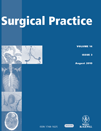Rectourethral fistula after radical prostatectomy: Transperineal repair in jack-knife position
Abstract
Background: Rectourethral fistula is a rare complication of radical prostatectomy. Risk factors include history of pelvic irradiation, cryotherapy, intraoperative rectal injury or transurethral resection of the prostate. Diagnosis of rectourethral fistula requires a high index of suspicion, and complete work-up with endoscopy and imaging studies. The majority of patients require operative intervention, with approaches ranging from transabdominal, transrectal, transanal, and transperineal routes.
Method: We report two patients with rectourethral fistula after radical prostatectomy. The first patient was a 59-year-old man who underwent an uncomplicated laparoscopic radical prostatectomy for early prostate cancer in another hospital. The second patient was a 64-year-old man who had local recurrence after cryotherapy for prostate cancer. He underwent salvage radical prostatectomy in a private hospital, which was complicated by intraoperative rectal injury.
Results: In both patients, the rectourethral fistulae were successfully repaired with a transperineal approach in the prone jack-knife position.
Conclusion: We found that the transperineal approach in the prone jack-knife position offered excellent exposure, allowed versatile surgical manoeuvres and produced successful repair with good continence outcomes.




